Multivariate Transfer Passenger Flow Forecasting with Data Imputation by Joint Deep Learning and Matrix Factorization
Abstract
1. Introduction
- We provide a reliable multivariate prediction model of Joint-IF by taking into account a variety of spatiotemporal factors (e.g., weather and location) for the accurate and efficient calculation of transfer passenger flow between metro and bus stations;
- Before performing the multi-interval forecasting task, we adopt an efficient temporal regularized MF for recovering transfer passenger flow under both missing situations to further enhance the robustness of the network-wide forecasting model;
- We conduct a large number of experiments on real-world transfer passenger flow. Compared with the baseline models, the results demonstrate that the proposed Joint-IF predicts the transfer passenger flow with lower error and better robustness.
2. Related Work
3. Methodology
3.1. Preliminaries
3.2. Model Architecture
3.2.1. Matrix Factorization-Based Imputation Module
3.2.2. Deep-Learning-Based Forecasting Module
3.3. Algorithm Complexity Analysis
3.4. Model Implementation
| Algorithm 1: Training Procedure of the Joint-IF Model |
| Input: Feature vectors q; transfer passenger flow matrix ; rank R; missing rate and missing scenarios; as the time lag; a spatial matrix and a temporal matrix ; AR regularized coefficient matrix ; the number of initial iterations and the number of estimated samples . |
| Output: Forecasting results of the transfer passenger flow |
| Initialization: Training parameters of the Joint-IF framework |
| Begin |
| For to + do |
| Calculate and update the spatial matrix : |
| Calculate and update the temporal matrix X: |
| For = 1, 2, …, , update X: |
| For = + 1, 2, …,, update X: |
| Calculate and update the AR coefficients : |
| Recover missing values in and update it. |
| Return complete transfer passenger flow . |
| Matching target variable and feature vectors q as the input of the prediction module. |
| For to + do |
| Forecasting future transfer passenger flow by Equations (6)–(11). |
| End for |
| Return as the prediction results of transfer passenger flow. |
4. Numerical Experiments
4.1. Dataset Description
4.2. Performance Metrics
4.3. Baseline Models
- (1)
- MLR [42]: The multiple linear regression (MLR) model considers the linear effect of multiple factors on the target variable. When these factors are linearly related to the target variable, the MLR model has excellent explanatory and predictive power.
- (2)
- GPR [43]: Generalized Poisson regression (GPR) is a typical linear regression model. If the target variable is counting data and complies with Poisson distribution, the GPR model has good explanatory performance and predictive results.
- (3)
- GWR [44]: Geographically weighted regression (GWR) is a spatial analysis algorithm. GWR explores the spatial variations of target variables at a given scale and the associated drivers by building the local regression equations at each point in the spatial ranges. Because it considers local spatial effects, GWR is capable of making predictions for target variables with higher accuracy.
- (4)
- RF [45]: The RF algorithm is a classifier that integrates multiple decision trees, with its output determined by the multiple output types of each tree. Several features and training data are randomly picked and the forecasting label with the most occurrences serves as the final result. The RF algorithm can tackle a large number of input variables and has good accuracy on the incomplete datasets.
- (5)
- LSTM [37]: LSTM is a temporal RNN which can control the transmission state using several gating structures. Compared to RNNs, LSTM enables better modeling performance in various complex long sequences.
4.4. Experimental Setups
4.5. Experimental Results and Analysis
4.5.1. Overall Analysis
- Under the RM and NM scenarios, the prediction errors were similar for transfer passenger flow with the same missing rates;
- The prediction errors gradually increased with the increase of missing rates, indicating the corresponding decrease of the forecasting performance. In the cases of the missing rates of 10% and 70%, it is obvious that the evaluation indexes (including MAE, MAPE and RMSE) were larger and the was smaller when the missing rate was 70%;
- The differences in the forecasting results were smaller when the missing rates were small, as illustrated in Figure 6. At the missing ratios of 10% and 30%, the differences among the assessment metrics were not significant and the predicted values were relatively close.
4.5.2. Performance Comparison with Baseline Models
4.6. Visualization Analysis
5. Conclusions
- (1)
- The Joint-IF model is capable of effectively repairing the transfer passenger flow between metro and bus under various missing combinations. Especially for those cases with large missing rates, Joint-IF can still maintain excellent repair performance, which is helpful for subsequent task of transfer passenger flow forecasting.
- (2)
- The Joint-IF model can accurately predict the future transfer passenger flows from metro stations to all their nearby bus stops. Compared with the baselines (e.g., GPR, GWR and MLR), Joint-IF yields greater performance gains and smaller prediction errors.
- (3)
- Overall, this study provides a reliable Joint-IF model for both accurate imputation and prediction of transfer passenger flow by considering the synergistic effects of multiple facts. Moreover, the visual analysis results can further confirm and explain the advantages of the Joint-IF over baselines, especially for GWR. These not only provide helpful insights for travelers and operators, but also provide a basis for later interpretable forecasting studies.
Author Contributions
Funding
Institutional Review Board Statement
Informed Consent Statement
Data Availability Statement
Acknowledgments
Conflicts of Interest
References
- Zhang, J.L.; Chen, F.; Cui, Z.Y.; Guo, Y.N.; Zhu, Y.D. Deep learning architecture for short-term passenger flow forecasting in urban rail transit. IEEE Trans. Intell. Transp. Syst. 2020, 22, 7004–7014. [Google Scholar] [CrossRef]
- Shi, F.; Zhou, Z.; Yao, J.; Huang, H.L. Incorporating transfer reliability into equilibrium analysis of railway passenger flow. Eur. J. Oper. Res. 2012, 220, 378–385. [Google Scholar] [CrossRef]
- Shang, P.; Li, R.M.; Guo, J.F.; Xian, K.; Zhou, X.S. Integrating Lagrangian and Eulerian observations for passenger flow state estimation in an urban rail transit network: A space-time-state hyper network-based assignment approach. Transport. Res. B-Meth. 2019, 121, 135–167. [Google Scholar] [CrossRef]
- Zhang, Z.; Wang, C.; Gao, Y.E.; Chen, J.W.; Zhang, Y.W. Short-term passenger flow forecast of rail transit station based on MIC feature selection and ST-LightGBM considering transfer passenger flow. Sci. Program. 2020, 2020, 1–15. [Google Scholar] [CrossRef]
- Nuzzolo, A.; Russo, F.; Crisalli, U. A doubly dynamic schedule-based assignment model for transit networks. Transp. Sci. 2001, 35, 268–285. [Google Scholar] [CrossRef]
- Musolino, G. Sustainable mobility as a service: Demand analysis and case studies. Information 2022, 13, 376. [Google Scholar] [CrossRef]
- Sun, Y.X.; Leng, B.; Guan, W. A novel wavelet-SVM short-time passenger flow prediction in Beijing subway system. Neurocomputing. 2015, 166, 109–121. [Google Scholar] [CrossRef]
- Liu, Y.; Liu, Z.Y.; Jia, R. DeepPF: A deep learning based architecture for metro passenger flow prediction. Transp. Res. Part C Emerg. Technol. 2019, 101, 18–34. [Google Scholar] [CrossRef]
- Wen, K.Y.; Zhao, G.T.; He, B.S.; Ma, J.; Zhang, H.X. A decomposition-based forecasting method with transfer learning for railway short-term passenger flow in holidays. Expert Syst. Appl. 2022, 189, 116102. [Google Scholar] [CrossRef]
- Li, J.L.; Wu, P.; Li, R.N.; Pian, Y.Z.; Huang, Z.L.; Xu, L.H.; Li, X.C. ST-CRMF: Compensated residual matrix factorization with spatial-temporal regularization for graph-based time series forecasting. Sensors 2022, 22, 5877. [Google Scholar] [CrossRef]
- Chen, X.Y.; Sun, L.J. Bayesian temporal factorization for multidimensional time series prediction. IEEE Trans. Pattern Anal. Mach. Intell. 2021, 44, 4659–4673. [Google Scholar] [CrossRef] [PubMed]
- Tang, L.Y.; Zhao, Y.; Cabrera, J.; Ma, J.; Tsui, K.L. Forecasting short-term passenger flow: An empirical study on shenzhen metro. IEEE Trans. Intell. Transp. Syst. 2018, 20, 3613–3622. [Google Scholar] [CrossRef]
- Yin, X.Y.; Wu, G.Z.; Wei, J.Z.; Shen, Y.M.; Qi, H.; Yin, B.C. Deep learning on traffic prediction: Methods, analysis and future directions. IEEE Trans. Intell. Transp. Syst. 2021, 23, 4927–4943. [Google Scholar] [CrossRef]
- Russo, F.; Rindone, C. Smart city for sustainable development: Applied processes from SUMP to MaaS at European level. Appl. Sci. 2023, 13, 1773. [Google Scholar] [CrossRef]
- Cascetta, E. Transportation Systems Engineering: Theory and Methods; Springer Science & Business Media: Berlin/Heidelberg, Germany, 2013. [Google Scholar]
- Xing, X.X.; Zhou, X.B.; Hong, H.K.; Huang, W.H.; Bian, K.G.; Xie, K.Q. Traffic flow decomposition and prediction based on robust principal component analysis. In Proceedings of the 2015 IEEE 18th International Conference on Intelligent Transportation Systems, Las Palmas de Gran Canaria, Spain, 15–18 September 2015; pp. 2219–2224. [Google Scholar]
- Gong, Y.S.; Li, Z.B.; Zhang, J.; Liu, W.; Zheng, Y.; Kirsch, C. Network-wide crowd flow prediction of sydney trains via customized online non-negative matrix factorization. In Proceedings of the 27th ACM International Conference on Information and Knowledge Management, Torino, Italy, 22–26 October 2018; pp. 1243–1252. [Google Scholar]
- Qu, L.; Li, L.; Zhang, Y.; Hu, J.M. PPCA-based missing data imputation for traffic flow volume: A systematical approach. IEEE Trans. Intell. Transp. Syst. 2009, 10, 512–522. [Google Scholar]
- Jia, X.Y.; Dong, X.Y.; Chen, M.; Yu, X.H. Missing data imputation for traffic congestion data based on joint matrix factorization. Knowl Based Syst. 2021, 225, 107114. [Google Scholar] [CrossRef]
- Chen, L.; Thakuriah, P.; Ampountolas, K. Short-term prediction of demand for ride-hailing services: A deep learning approach. J. Big Data Anal. Transp. 2021, 3, 175–195. [Google Scholar] [CrossRef]
- Sun, B.; Sun, T.; Jiao, P.P. Spatio-temporal segmented traffic flow prediction with ANPRS data based on improved XGBoost. J. Adv. Transp. 2021, 2021, 1–24. [Google Scholar] [CrossRef]
- Mousavizadeh Kashi, S.O.; Akbarzadeh, M. A framework for short-term traffic flow forecasting using the combination of wavelet transformation and artificial neural networks. J. Intell. Transp. Syst. 2019, 23, 60–71. [Google Scholar] [CrossRef]
- Wang, S.L.; Patwary, A.U.Z.; Huang, W. A general framework for combining traffic flow models and Bayesian network for traffic parameters estimation. Transp. Res. Part C Emerg. Technol. 2022, 139, 103664. [Google Scholar] [CrossRef]
- Feng, X.X.; Ling, X.Y.; Zheng, H.F.; Chen, Z.H.; Xu, Y.W. Adaptive multi-kernel SVM with spatial–temporal correlation for short-term traffic flow prediction. IEEE Trans. Intell. Transp. Syst. 2018, 20, 2001–2013. [Google Scholar] [CrossRef]
- Lv, W.J.; Lv, Y.B.; Ouyang, Q.; Ren, Y. A bus passenger flow prediction model fused with point-of-interest data based on extreme gradient boosting. Appl. Sci. 2022, 12, 940. [Google Scholar] [CrossRef]
- Ma, X.L.; Tao, Z.M.; Wang, Y.H.; Yu, H.Y.; Wang, Y.P. Long short-term memory neural network for traffic speed prediction using remote microwave sensor data. Transp. Res. Part C Emerg. Technol. 2015, 54, 187–197. [Google Scholar] [CrossRef]
- Zhao, Z.; Chen, W.H.; Wu, X.M.; Chen, P.C.; Liu, J.M. LSTM network: A deep learning approach for short-term traffic forecast. IET Intell. Transp. Syst. 2017, 11, 68–75. [Google Scholar] [CrossRef]
- Tian, Y.; Zhang, K.L.; Li, J.Y.; Lin, X.X.; Yang, B.L. LSTM-based traffic flow prediction with missing data. Neurocomputing 2018, 318, 297–305. [Google Scholar] [CrossRef]
- Zheng, H.F.; Lin, F.; Feng, X.X.; Chen, Y.J. A hybrid deep learning model with attention-based conv-LSTM networks for short-term traffic flow prediction. IEEE Trans. Intell. Transp. Syst. 2020, 22, 6910–6920. [Google Scholar] [CrossRef]
- Khaled, A.; Elsir, A.M.T.; Shen, Y.M. TFGAN: Traffic forecasting using generative adversarial network with multi-graph convolutional network. Knowl. Based Syst. 2022, 249, 108990. [Google Scholar] [CrossRef]
- Rindone, C. Sustainable mobility as a service: Supply analysis and test cases. Information 2022, 13, 351. [Google Scholar] [CrossRef]
- Musolino, G.; Rindone, C.; Vitetta, A. Models for supporting mobility as a service (MaaS) design. Smart Cities. 2022, 5, 206–222. [Google Scholar] [CrossRef]
- Nuzzolo, A.; Comi, A. Dynamic optimal travel strategies in intelligent stochastic transit networks. Information 2021, 12, 281. [Google Scholar] [CrossRef]
- Li, J.L.; Xu, L.H.; Li, R.N.; Wu, P.; Huang, Z.L. Deep spatial-temporal bi-directional residual optimisation based on tensor decomposition for traffic data imputation on urban road network. Appl. Intell. 2022, 52, 11363–11381. [Google Scholar] [CrossRef]
- Li, J.L.; Li, R.N.; Huang, Z.L.; Wu, P.; Xu, L.H. Dynamic adaptive generative adversarial networks with multi-view temporal factorizations for hybrid recovery of missing traffic data. Neural. Comput. Appl. 2022, 35, 7677–7696. [Google Scholar] [CrossRef]
- Li, R.N.; Qin, Y.; Wang, C.H.; Li, M.Y.; Chu, X.W. A blockchain-enabled framework for enhancing scalability and security in IIoT. IEEE Trans. Ind. Inform. 2022, 2022, 3210216. [Google Scholar] [CrossRef]
- Wu, P.; Huang, Z.L.; Pian, Y.Z.; Xu, L.H.; Li, J.L.; Chen, K.X. A combined deep learning method with attention-based LSTM model for short-term traffic speed forecasting. J. Adv. Transp. 2020, 2020, 1–15. [Google Scholar] [CrossRef]
- Wu, P.; Li, J.L.; Pian, Y.Z.; Li, X.C.; Huang, Z.L.; Xu, L.H.; Li, R.N. How determinants affect transfer ridership between metro and bus systems: A multivariate generalized poisson regression analysis method. Sustainability 2022, 14, 9666. [Google Scholar] [CrossRef]
- Li, J.L.; Sun, L.J.; Li, R.N.; Lu, Y.C. Application of siSVR-Vis/NIR to the nondestructive determination of acid detergent fiber content in corn straw. Optik 2020, 202, 163717. [Google Scholar] [CrossRef]
- Li, R.N.; Qin, Y.; Wang, J.B.; Wang, H.Y. AMGB: Trajectory prediction using attention-based mechanism GCN-BiLSTM in IOV. Pattern Recognit. Lett. 2023, 169, 17–27. [Google Scholar] [CrossRef]
- Li, J.L.; Sun, L.J.; Li, Y.S.; Lu, Y.C.; Pan, X.Y.; Zhang, X.L.; Liu, Y.Y.; Song, Z.W. Rapid prediction of acid detergent fiber content in corn stover based on NIR-spectroscopy technology. Optik 2019, 180, 34–45. [Google Scholar] [CrossRef]
- Wu, P.; Xu, L.H.; Zhong, L.S.; Gao, K.; Qu, X.B.; Pei, M.Y. Revealing the determinants of the intermodal transfer ratio between metro and bus systems considering spatial variations. J. Transp. Geogr. 2022, 104, 103415. [Google Scholar] [CrossRef]
- Bae, S.; Famoye, F.; Wulu, J.T. A rich family of generalized Poisson regression models with applications. Math. Comput. Simul. 2005, 69, 4–11. [Google Scholar] [CrossRef]
- Li, W.X.; Chen, S.W.; Dong, J.S.; Wu, J.X. Exploring the spatial variations of transfer distances between dockless bike-sharing systems and metros. J. Transp. Geogr. 2021, 92, 103032. [Google Scholar] [CrossRef]
- Li, J.H.; Zhu, D.S.; Li, C.X. Comparative analysis of BPNN, SVR, LSTM, Random Forest, and LSTM-SVR for conditional simulation of non-Gaussian measured fluctuating wind pressures. Mech. Syst. Signal Process. 2022, 178, 109285. [Google Scholar] [CrossRef]
- Li, J.L.; Sun, L.J.; Li, R.N. Nondestructive detection of frying times for soybean oil by NIR-spectroscopy technology with Adaboost-SVM (RBF). Optik 2020, 206, 164248. [Google Scholar] [CrossRef]
- Ran, Z.Y.; Sun, L.J.; Liu, Y.Y.; Pan, X.Y.; Li, J.L.; Liu, Y. Forward and backward interval partial least squares method for quantitative analysis of frying oil quality. Infrared Phys. Technol. 2020, 105, 103207. [Google Scholar] [CrossRef]
- Russo, F.; Rindone, C. Regional transport plans: From direction role denied to common rules identified. Sustainability 2021, 13, 9052. [Google Scholar] [CrossRef]
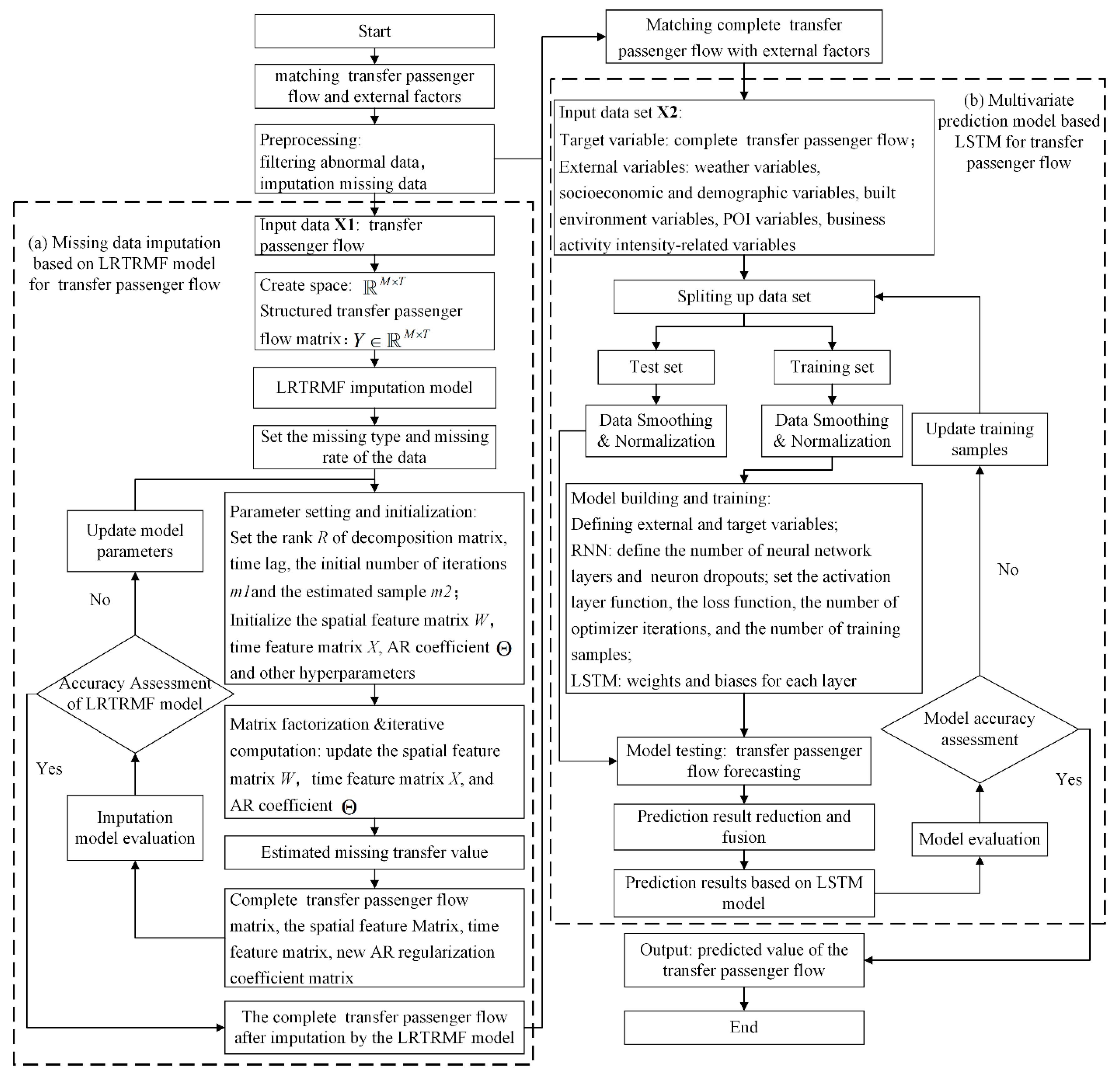
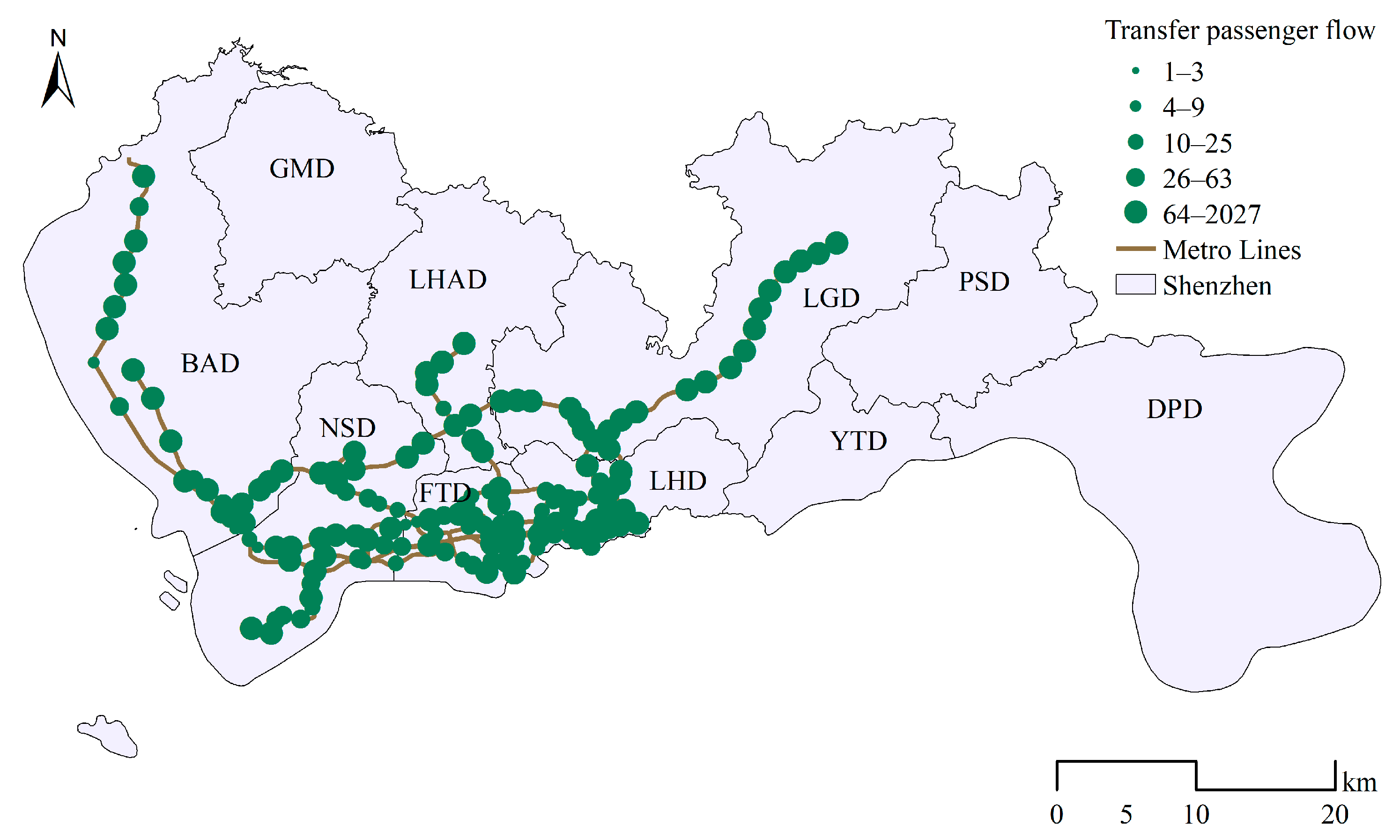
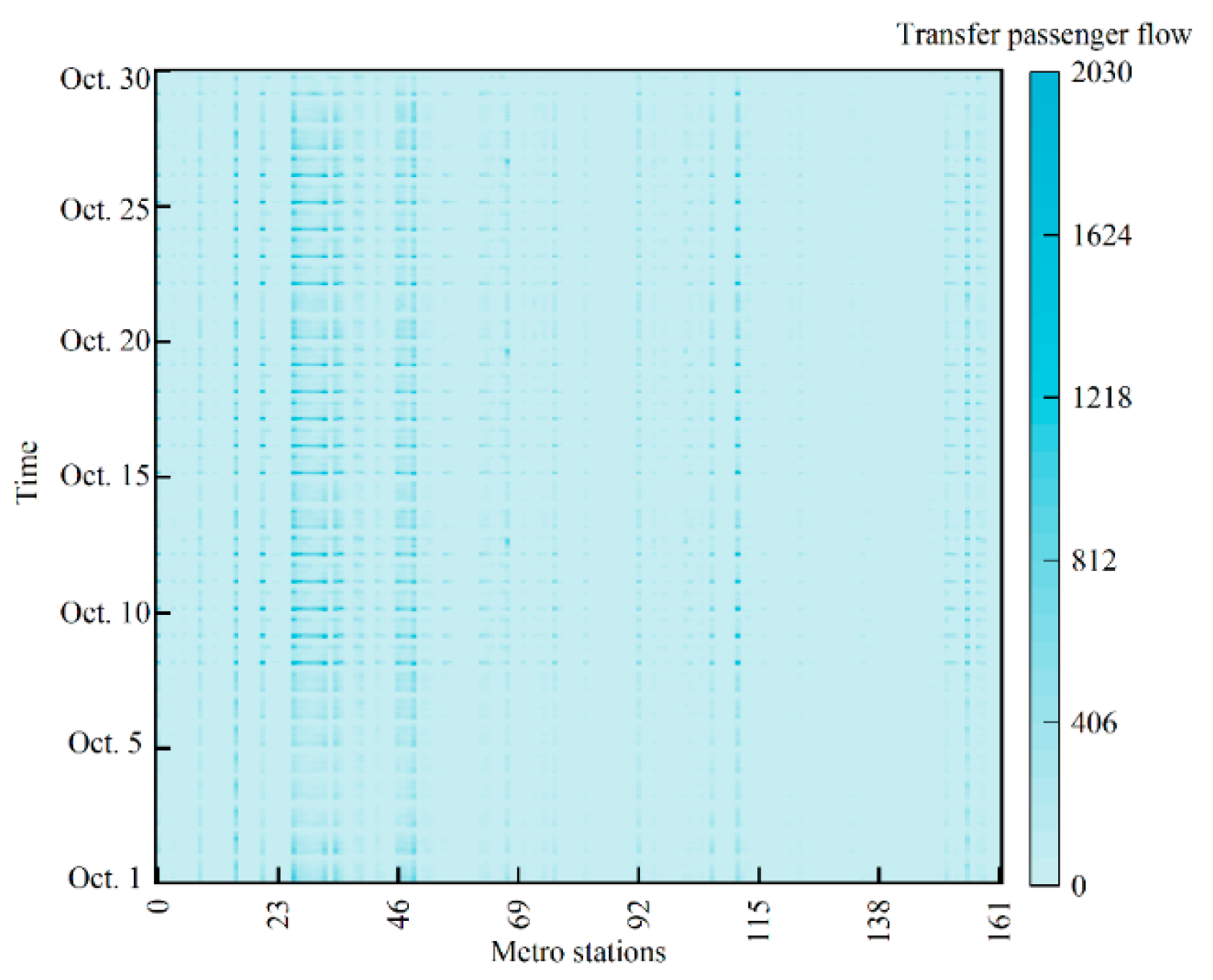
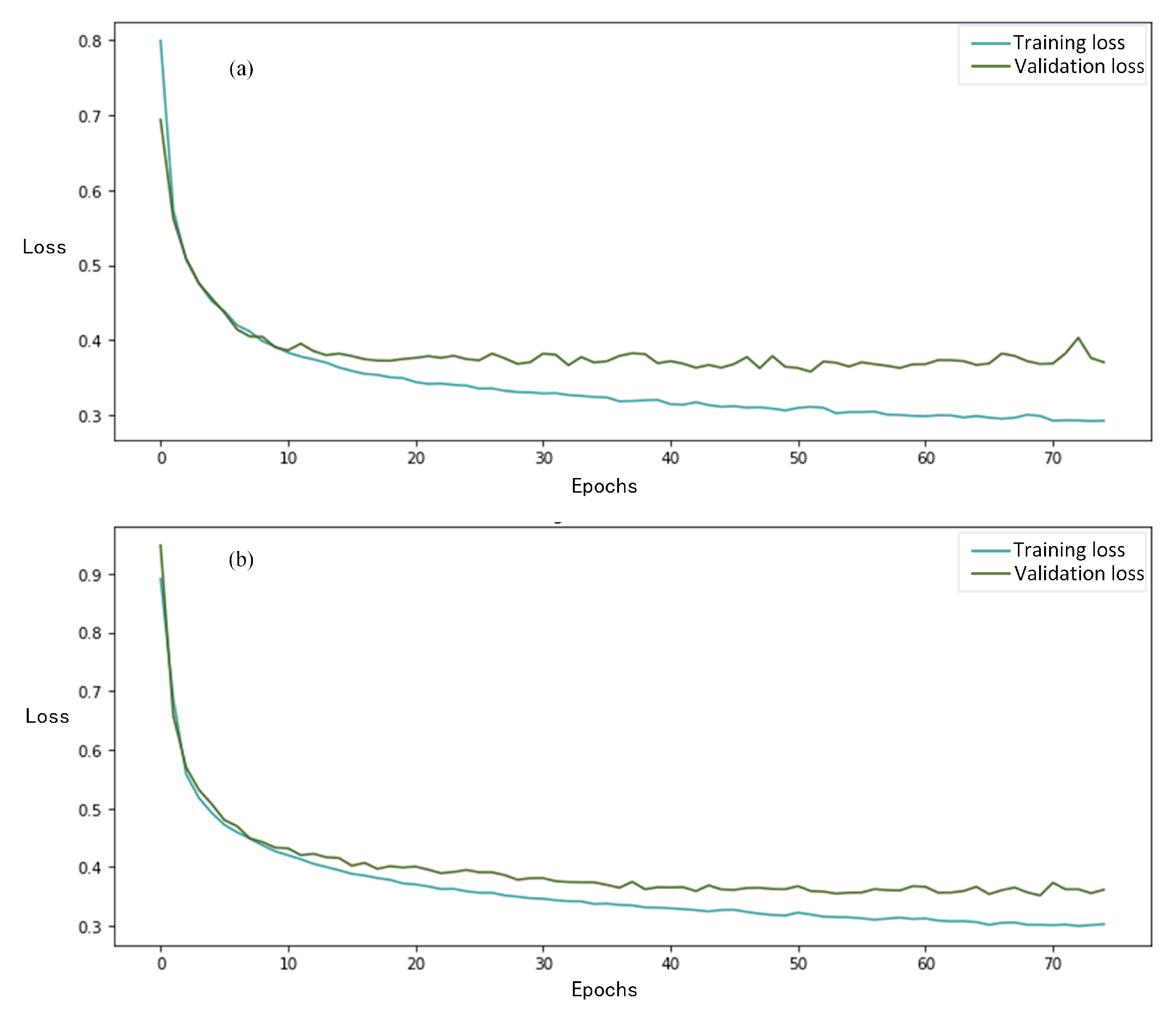

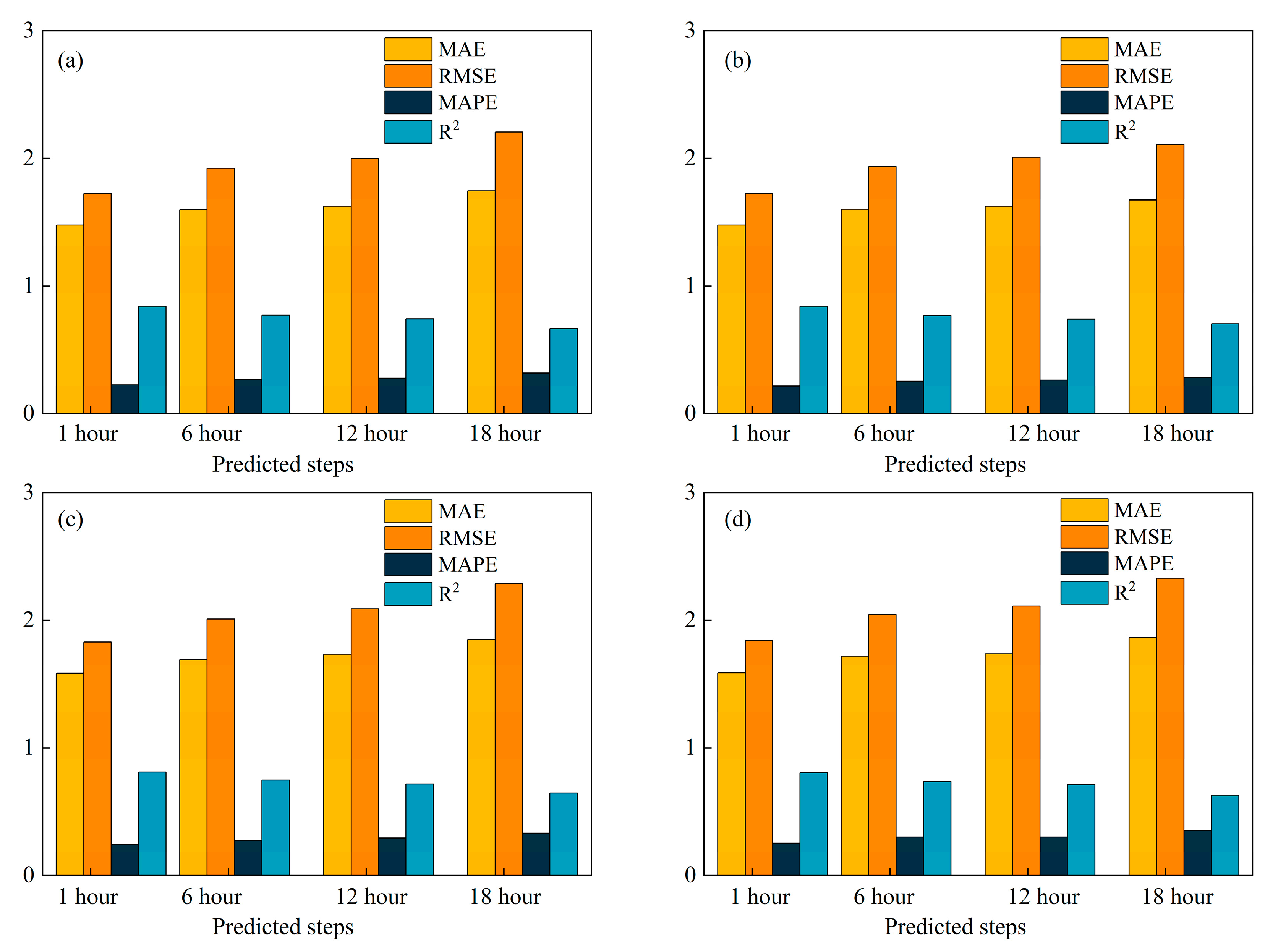

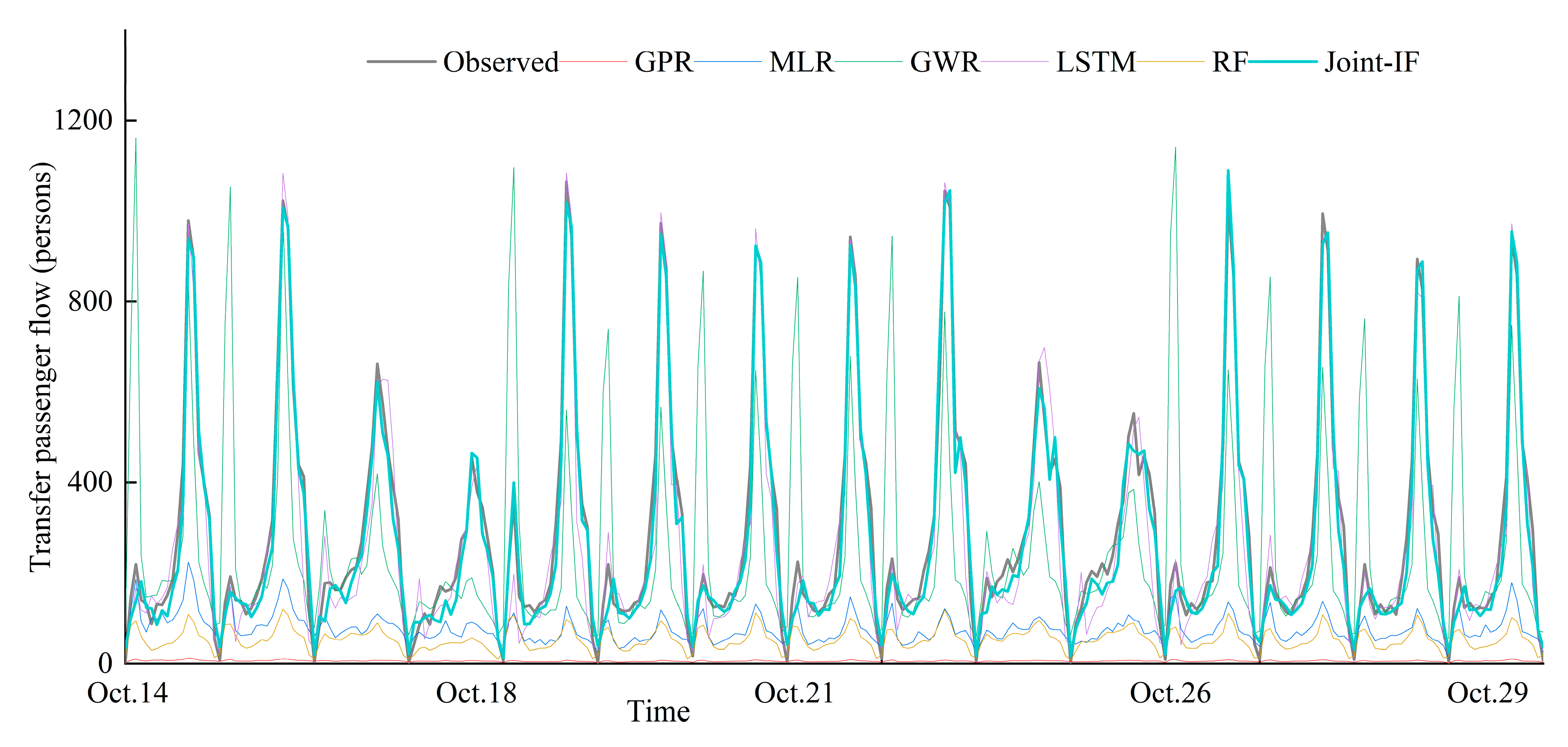
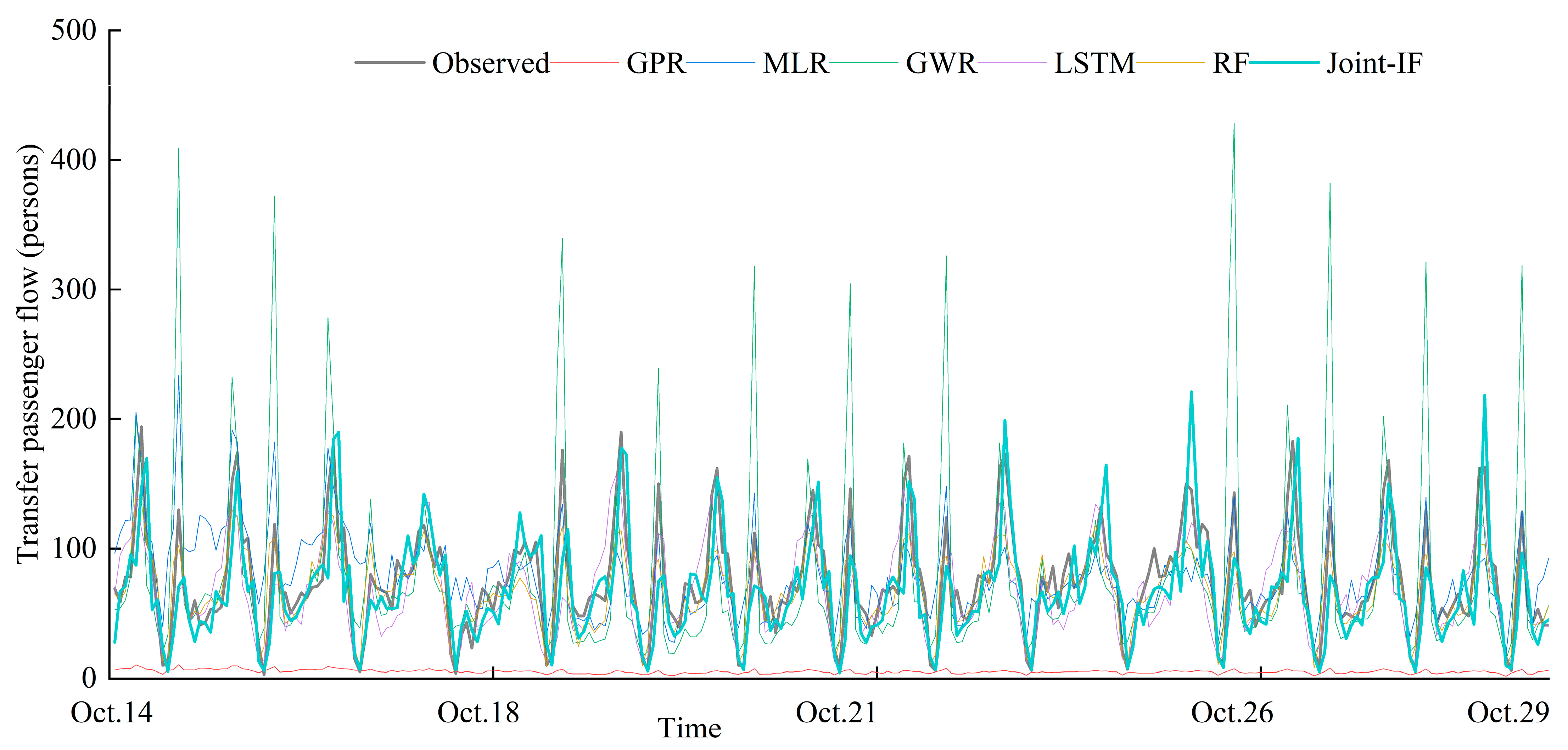
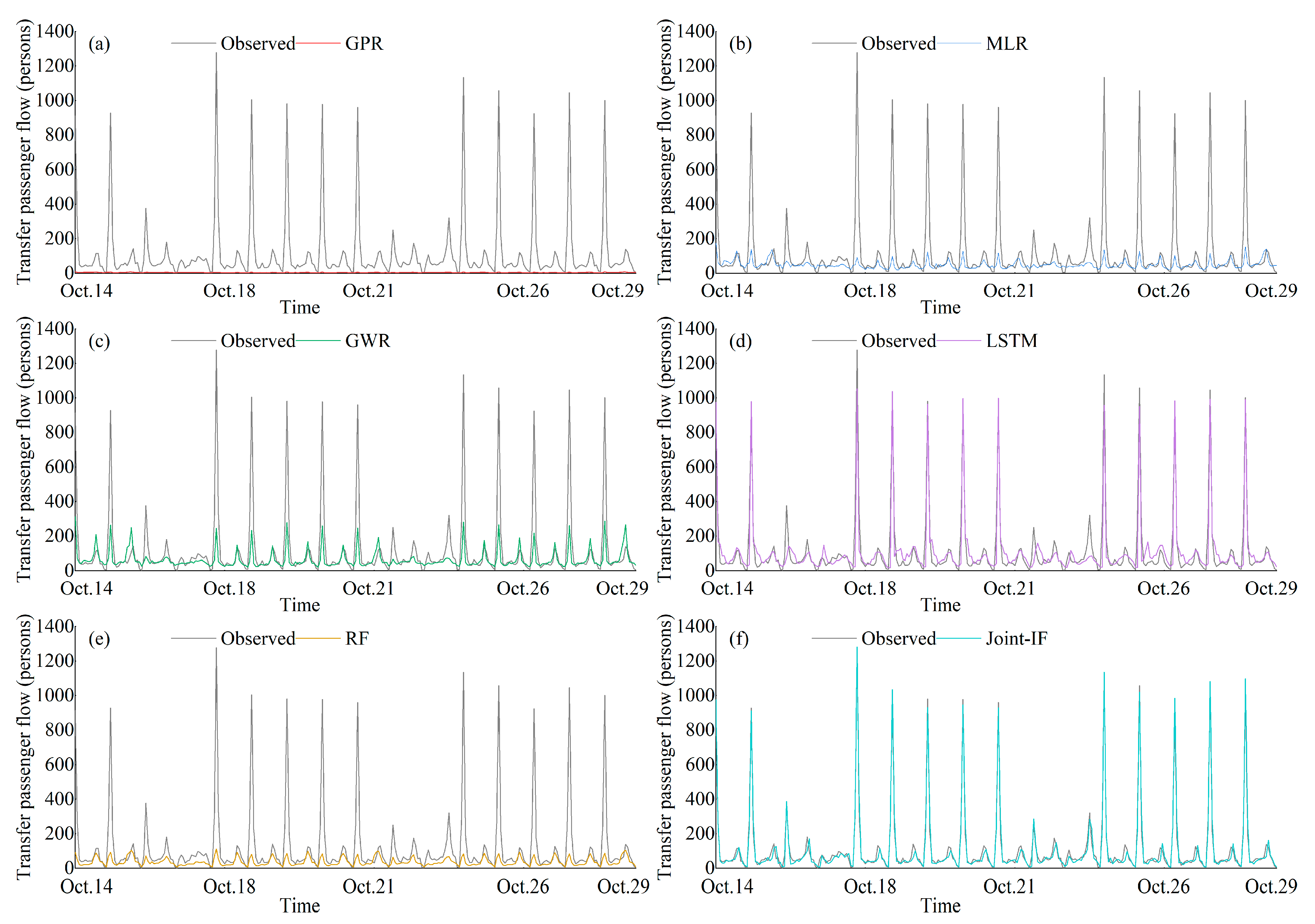
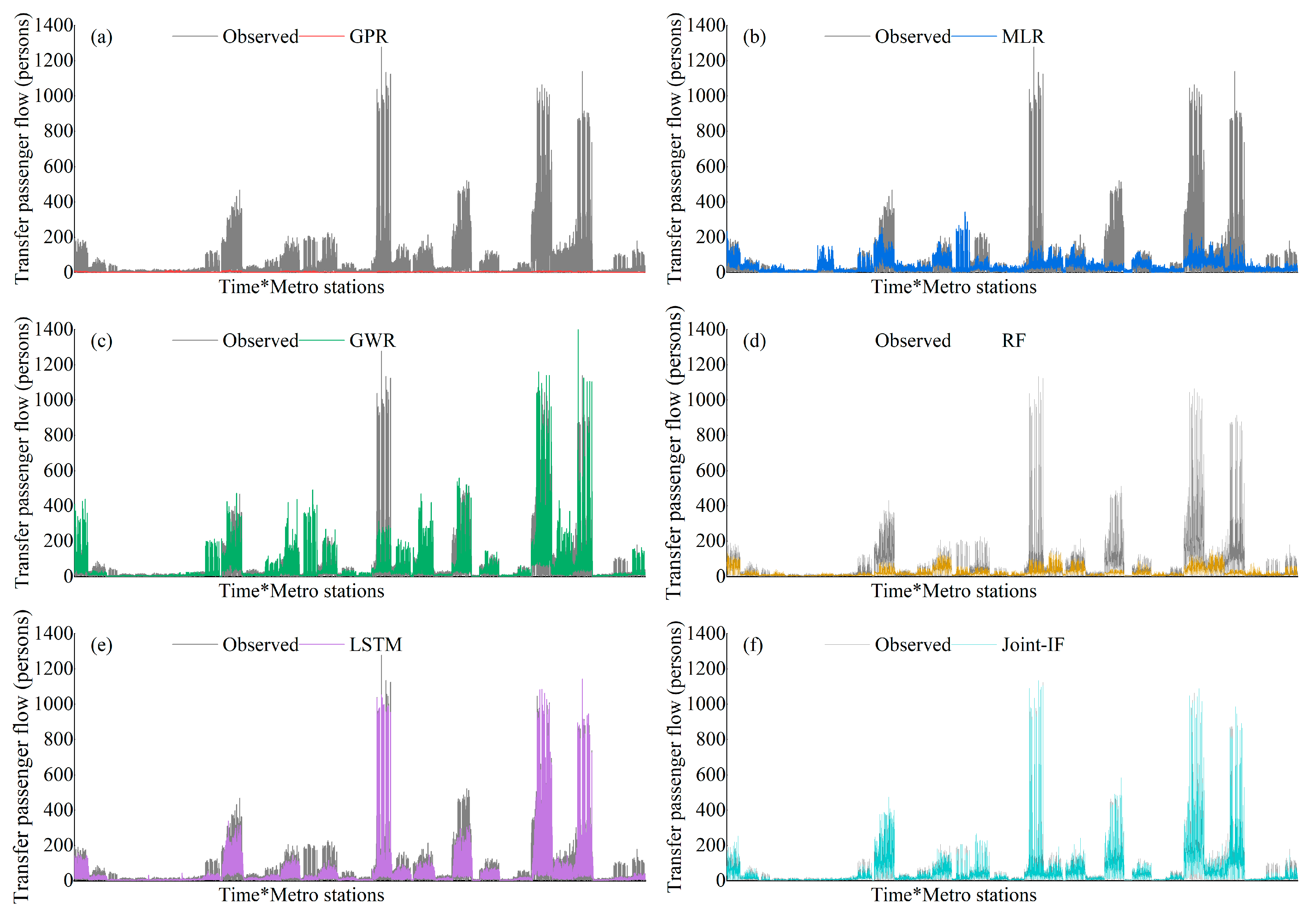
| Variables | Definitions | Unit | Mean | Sd. | |
|---|---|---|---|---|---|
| Target variable | Transfer passenger flow | The number of transfer passengers per hour at each metro station | Persons | 56 | 131 |
| External factors | Weather variables | ||||
| Wind Speed | The maximum wind speed per hour | m/s | 3.14 | 1.34 | |
| Temperature | The maximum temperature per hour | °C | 26.74 | 3.47 | |
| Visibility | Minimum visibility per hour | m | 33.75 | 10.13 | |
| Precipitation | The cumulative precipitation per hour | mm | 0.15 | 0.93 | |
| Socio-economic and demographic variables (near metro station) | |||||
| Housing Price | Average housing prices | 8932.7 | 2585.9 | ||
| Housing Rent | Average housing rent | 12.57 | 3.26 | ||
| Geographical GDP | GDP level | USD billion | 40.84 | 6.71 | |
| Population Density | Hourly crowd density | - | 5.62 | 1.19 | |
| Built environment variables (near metro station) | |||||
| Transfer Distance | Average transfer distance between metro station and bus stops | m | 328.20 | 91.65 | |
| Bus Lines | The number of bus lines | 19 | 8 | ||
| Bus Stops | The number of bus stops | - | 26 | 11 | |
| Distance from CBD | Distance of metro station from CBD | m | 9600 | 6604 | |
| POI information (near metro station) | |||||
| Scenic Spots | Number of scenic spots | - | 13 | 9 | |
| Shopping Malls | The number of shopping malls | - | 27 | 20 | |
| Technology and Culture | The number of technology and culture | - | 195 | 119 | |
| Finance and Insurance | The number of finance and insurance | - | 124 | 123 | |
| Business Housing | The number of business housing | - | 214 | 143 | |
| Hotel Services | The number of hotel services | - | 94 | 88 | |
| Parameter | Settings |
|---|---|
| Loss | MSE |
| Optimizer | Adam |
| Batch_size | 512 |
| Epoch | 75 |
| Numbers | Layers | Parameters | Size |
|---|---|---|---|
| 1 | LSTM layer | Param | 3760 |
| 2 | Dropout (0.1) layer | Param | 0 |
| 3 | LSTM layer | Param | 2160 |
| 4 | Dropout (0.1) layer | Param | 0 |
| 5 | LSTM layer | Param | 2880 |
| 6 | Dropout (0.1) layer | Param | 0 |
| 7 | Dense layer | Param | 84 |
| Models | Evaluation Metrics | |||
|---|---|---|---|---|
| MAE | MAPE | RMSE | ||
| MLR | 2.26 | 0.477 | 2.91 | 0.645 |
| GPR | 6.579 | 0.646 | 8.666 | 0.552 |
| GWR | 1.589 | 0.251 | 1.852 | 0.89 |
| RF | 2.019 | 0.366 | 2.487 | 0.764 |
| LSTM | 1.772 | 0.281 | 2.247 | 0.806 |
| Joint-IF | 1.567 | 0.197 | 1.836 | 0.911 |
Disclaimer/Publisher’s Note: The statements, opinions and data contained in all publications are solely those of the individual author(s) and contributor(s) and not of MDPI and/or the editor(s). MDPI and/or the editor(s) disclaim responsibility for any injury to people or property resulting from any ideas, methods, instructions or products referred to in the content. |
© 2023 by the authors. Licensee MDPI, Basel, Switzerland. This article is an open access article distributed under the terms and conditions of the Creative Commons Attribution (CC BY) license (https://creativecommons.org/licenses/by/4.0/).
Share and Cite
Li, J.; Wu, P.; Guo, H.; Li, R.; Li, G.; Xu, L. Multivariate Transfer Passenger Flow Forecasting with Data Imputation by Joint Deep Learning and Matrix Factorization. Appl. Sci. 2023, 13, 5625. https://doi.org/10.3390/app13095625
Li J, Wu P, Guo H, Li R, Li G, Xu L. Multivariate Transfer Passenger Flow Forecasting with Data Imputation by Joint Deep Learning and Matrix Factorization. Applied Sciences. 2023; 13(9):5625. https://doi.org/10.3390/app13095625
Chicago/Turabian StyleLi, Jinlong, Pan Wu, Hengcong Guo, Ruonan Li, Guilin Li, and Lunhui Xu. 2023. "Multivariate Transfer Passenger Flow Forecasting with Data Imputation by Joint Deep Learning and Matrix Factorization" Applied Sciences 13, no. 9: 5625. https://doi.org/10.3390/app13095625
APA StyleLi, J., Wu, P., Guo, H., Li, R., Li, G., & Xu, L. (2023). Multivariate Transfer Passenger Flow Forecasting with Data Imputation by Joint Deep Learning and Matrix Factorization. Applied Sciences, 13(9), 5625. https://doi.org/10.3390/app13095625






